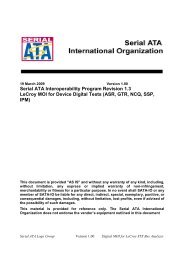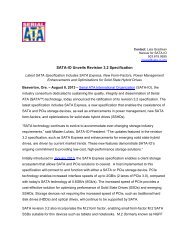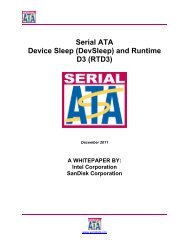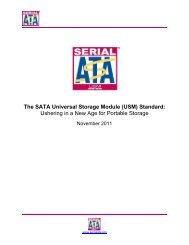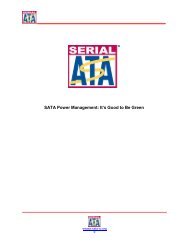1.0 - SATA-IO
1.0 - SATA-IO
1.0 - SATA-IO
- No tags were found...
Create successful ePaper yourself
Turn your PDF publications into a flip-book with our unique Google optimized e-Paper software.
Tektronix, Inc.Test TX-06 - Gen-1 Differential Mode Return LossPurpose: To verify that the Differential Mode Return Loss of the PUT’s transmitter is within the conformancelimits.References:[1] <strong>SATA</strong> Standard, 7.2.1, Table 21 – Transmitter Specifications[2] Ibid, 7.2.2.2.3 – TX Differential Mode Return Loss (Gen2i)[3] Ibid, 7.4.10 – Return Loss and Impedance Balance[4] <strong>SATA</strong> unified test document, 2.11.3[5] <strong>SATA</strong> ECN_21/22 – TX Differential Mode Return Loss (Gen1i)Resource Requirements:See Appendix A.Last Template Modification: April 10, 2006 (Version <strong>1.0</strong>)Discussion:Reference [1] specifies the Transmitter Specification conformance limits for <strong>SATA</strong> devices. Thisspecification includes conformance limits for the Differential Mode Return Loss. Reference [2] provides thedefinition of this term for the purposes of <strong>SATA</strong> testing. Reference [3] defines the measurement requirements forthis test.Test Setup:1. Matched length SMA cables have to be connected to the TDS/CSA8200 sampling oscilloscope; eachpair of the transmitter and receiver to one sampling module. The TDR single-ened signal amplitudeshould be less than 139mV peak-to-peak this can be achieved by introducing 6dB attenuators in themeasurement path, this will provide approximately 125mV peak-to-peak TDR signal amplitude. Incases when the PUT does not support “disconnect” operation, the measurement setup described inappendix D can be used.2. Each sampling module of the oscilloscope needs to be deskewed for acquisition using external sourcebefore connecting the fixtures. There is no need to deskew between the modules since themeasurements are done for the pairs within the modules. The sources deskew has to be performed inodd mode (source steps are of the opposite polarity). The step signals should arrive at the PUT at thesame time. Both, acquisition and TDR deskew are to be performed at the SMA reference plane3. Set 4000 acquisition points and 1ns/div in “Horizontal” menu and 300 averages in the “Acquisition”menu of TDS8200. Set math to a difference for TDR signals for each module. The instrument’s setupfrom TX-01 test can be reused (the rise time is filtered to 40ps (10-90%) rise time).4. Power up the product under test (PUT), complete a full OOB sequence and broadcast a MFTP pattern.Test Procedure:1. This procedure should be applied to the worst case port (in a multi-port system/host) as determinedthrough the worst case port identification MOI.2. Acquire the differential open reference using IConnect “Acquisition” tool.3. Connect the PUT and acquire TDRdd waveform.4. Use S-parameter tool of IConnect to compute differential return loss (Sdd11) of the transmitter. Theresulting waveform will be displayed in the frequency domain viewer.5. Using cursors measure the maximum values for each frequency range given in reference [1].Differential return loss measurements are shown in Figure 2.4.6. Record the results.<strong>SATA</strong> Rx/Tx MOI Revision 1.1 ver <strong>1.0</strong>23




